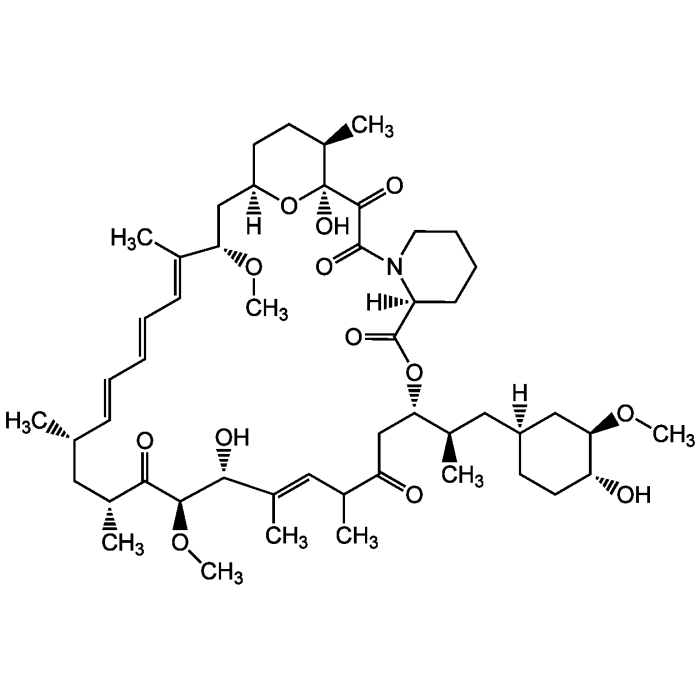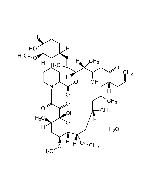Cookie Policy: This site uses cookies to improve your experience. You can find out more about our use of cookies in our Privacy Policy. By continuing to browse this site you agree to our use of cookies.
AdipoGen Life Sciences
Rapamycin
As low as
35
CHF
CHF 35.00
In stock
Only %1 left
AG-CN2-0025-C100100 µgCHF 35.00
AG-CN2-0025-M0011 mgCHF 45.00
AG-CN2-0025-M0055 mgCHF 85.00
AG-CN2-0025-M02525 mgCHF 210.00

| Product Details | |
|---|---|
| Synonyms | Sirolimus; Rapamune; NSC 226080; Antibiotic AY-22989; WY-090217; RAPA; SILA 9268A; CCRIS 9024 |
| Product Type | Chemical |
| Properties | |
| Formula |
C51H79NO13 |
| MW | 914.2 |
| Merck Index | 14: 8114 |
| CAS | 53123-88-9 |
| RTECS | VE6250000 |
| Source/Host Chemicals | Isolated from Streptomyces hygroscopicus. |
| Purity Chemicals | ≥98% |
| Appearance | White to off-white solid. |
| Solubility | Soluble in DMSO (20mg/ml), methanol (10mg/ml) or chloroform (10mg/ml). |
| InChi Key | QFJCIRLUMZQUOT-KIHCOMIKSA-N |
| Smiles | [H][C@@]1(C[C@@H](C)[C@@H]2CC(=O)C(C)\C=C(C)\[C@@H](O)[C@@H](OC)C(=O)[C@H](C)C[C@H](C)\C=C\C=C\C=C(C)\[C@H](C[C@@]3([H])CC[C@@H](C)[C@](O)(O3)C(=O)C(=O)N3CCCC[C@@]3([H])C(=O)O2)OC)CC[C@@H](O)[C@@H](C1)OC |
| Shipping and Handling | |
| Shipping | AMBIENT |
| Short Term Storage | +4°C |
| Long Term Storage | -20°C |
| Use/Stability | Stable for at least 2 years after receipt when stored at -20°C. |
| Documents | |
| MSDS |
 Download PDF Download PDF |
| Product Specification Sheet | |
| Datasheet |
 Download PDF Download PDF |
Description
- Antibiotic.
- Antibacterial and antifungal properties [1, 2].
- Forms a complex with FKBP12 and inhibits the mammalian target of rapamycin (mTOR). Inhibits the response to interleukin-2 (IL-2), and thereby blocks activation of T and B cells [3, 5, 6, 11].
- Potent immunosuppressant [4, 10] used as an alternative to calcineurin inhibitors [12].
- Restricts the proliferation of smooth-muscle cells by blocking cell cycle progression at the G1/S transition [7, 13].
- Anti-proliferative. Antitumor compound [14, 15].
- Apoptosis enhancer. Activator of autophagy both in vitro and in vivo [8, 9].
- Anti-HIV and anti-aging compound [16, 17].
- Neuroprotective [18].
- Suppressor for self-renewal and vascular differentiation potential in hemangioma stem cells [19].
- mTORC1 inhibitor [20].
Product References
- Rapamycin (AY-22,989), a new antifungal antibiotic. I. Taxonomy of the producing streptomycete and isolation of the active principle: C. Vezina, et al.; J. Antibiot. (Tokyo) 28, 721 (1975)
- Rapamycin (AY-22,989), a new antifungal antibiotic. II. Fermentation, isolation and characterization: S.N. Sehgal, et al.; J. Antibiot. (Tokyo) 28, 727 (1975)
- Inhibition of T and B lymphocyte proliferation by rapamycin: J.E. Kay, et al.; Immunology 72, 544 (1991)
- FK506 and rapamycin: novel pharmacological probes of the immune response: J.Y. Chang, et al.; TIPS 12, 218 (1991) (Review)
- Rapamycin-FKBP specifically blocks growth-dependent activation of and signaling by the 70 kd S6 protein kinases: J. Chung, et al.; Cell 69, 1227 (1992),
- Rapamycin inhibition of interleukin-2-dependent p33cdk2 and p34cdc2 kinase activation in T lymphocytes: W.G. Morice, et al.; J. Biol. Chem. 268, 22737 (1993)
- A mammalian protein targeted by G1-arresting rapamycin-receptor complex: E.J. Brown, et al.; Nature 369, 756 (1994)
- Rapamycin, a potent immunosuppressive drug, causes programmed cell death in B lymphoma cells: S. Muthukkumar, et al.; Transplantation 60, 264 (1995)
- Rapamycin enhances apoptosis and increases sensitivity to cisplatin in vitro: Y. Shi, et al.; Cancer Res. 55, 1982 (1995)
- Mechanism of action of the immunosuppressant rapamycin: F.J. Dumont & Q. Su; Life Sci. 58, 373 (1996) (Review)
- Rapamycin causes poorly reversible inhibition of mTOR and induces p53- independent apoptosis in human rhabdomyosarcoma cells: H. Hosoi, et al.; Cancer Res. 59, 886 (1999)
- Rapamycin in transplantation: a review of the evidence: R.N. Saunders, et al.; Kidney Int. 59, 3 (2001) (Review)
- Rapamycin in cardiovascular medicine: P.N. Ruygrok, et al.; Intern. Med. J. 33, 103 (2003) (Review)
- Rapamycin: an anti-cancer immunosuppressant?: B.K. Law; Crit. Rev. Oncol. Hematol. 56, 47 (2005) (Review)
- Tubers and tumors: rapamycin therapy for benign and malignant tumors: D.R. Plas & G. Thomas; Curr. Opin. Cell Biol. 21, 230 (2009) (Review)
- Potential use of rapamycin in HIV infection: M. Donia, et al.; Br. J. Clin. Pharmacol. 70, 784 (2010) (Review)
- Resveratrol and rapamycin: are they anti-aging drugs? M. Kaeberlein; Bioessays 32, 96 (2010)
- Fighting neurodegeneration with rapamycin: mechanistic insights: J. Bové, et al.; Nat. Rev. Neurosci. 12, 437 (2011) (Review)
- Rapamycin suppresses self-renewal and vasculogenic potential of stem cells isolated from infantile hemangioma: S. Greenberger, et al.; J. Invest. Dermatol. 131, 2467 (2011)
- Inhibition of the PI3K–Akt and mTORC1 signaling pathways promotes the elongation of vascular endothelial cells: K. Tsuji-Tamura & M. Ogawa; J. Cell Sci. 129, 1165 (2016)
- Chemically defined and growth-factor-free culture system for the expansion and derivation of human pluripotent stem cells: S. Yasuda, et al.; Nature Biomed. Eng. 2, 173 (2018)
- PtdIns4P on dispersed trans-Golgi network mediates NLRP3 inflammasome activation: J. Chen & Z.J. Chen, Nat. 564, 71 (2018)







